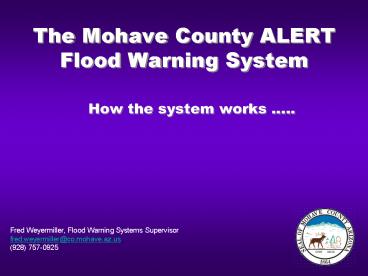The Mohave County ALERT Flood Warning System - PowerPoint PPT Presentation
1 / 17
Title: The Mohave County ALERT Flood Warning System
1
The Mohave County ALERT Flood Warning System
- How the system works ..
Fred Weyermiller, Flood Warning Systems
Supervisor fred.weyermiller_at_co.mohave.az.us (928)
757-0925
2
- Mohave County currently manages 309 sensors
located at 109 sites. - These sites are located not only throughout
Mohave County but also southern Utah, Yavapai
County and the Hualapai Indian Reservation.
3
- Transmitters at these sites communicate the
raw data utilizing 5 watt VHF radios to
repeaters, which in turn forward or pass along
the data to base collection stations.
Once the data reaches the base station it is
converted from its raw format into values that we
can relate to.
4
- Mohave County currently manages four base
collection stations designed to collect raw
weather data from the network. Two stations are
maintained at the Public Works facility in
Kingman. One station is the main server for the
system and one is for diagnostic and testing
purposes. - Base collection stations are also located in
the County Emergency Operations Center and the
Public Works facility in Beaver Dam. - Each base station is equipped with an antenna,
data receiver and a data decoder which is
connected to the computer.
5
- Each base collection station uses
Environmental Data Acquisition and Database
Management software to record and manage data
from the field sensors.
6
- The server also monitors sensors for alarm
threshold values such as heavy rainfall, stream
flow and roadway surface ice.
7
- When pre-defined alarm thresholds are met, the
server automatically dispatches these alarms to
its recipients via cellular text messages and
alpha-numeric pagers. - Recipients of these alarms include Emergency
Management personnel, Traffic Control personnel,
Road Maintenance personnel, Sheriffs Office
coordinators and dispatchers, Public Works
Management personnel and Flood Control District
personnel.
8
- Public Works responds to or investigates all
alarms generated from the ALERT Flood Warning
System.
9
- The 12 diameter waterproof standpipe houses
all of the sensors and the data transmitter
equipment.
10
- Sites like this one located near Mineral Park
are designed to collect rainfall data only. - This site is equipped with a 6dB gain
directional antenna which improves the quality of
the radio signal over longer distances. - All of the sites are solar charged 12 VDC.
11
- Sites such as this one located along
Interstate 40 _at_ Frees Wash measure both rainfall
and stream flow. - A low voltage (0-5V) submersible pressure
transducer housed in a 2 inch diameter rigid pipe
and anchored at the bottom of the wash sends
information to the data transmitter. - There are currently 40 sites in the network
that monitor stream flow.
12
- Repeaters such as the Gold Road Crest site
located near Oatman receive data from other sites
and forward it to other repeaters. This allows
the network to relay data from distances up to
150 miles away. The network currently has nine
repeaters.
13
- This map shows all of the repeaters in the
Mohave County Network along with their
communication paths - The Hayden Peak repeater located south of
Kingman at an elevation of 8,335 feet is the
backbone of the network. All network data must
pass through this repeater to reach the base
station.
14
- The ALERT transmitter which is housed inside
the standpipe collects information from the
sensors and transmits the data to repeaters
through the use of VHF radios. - This particular transmitter is 12 VDC powered
and capable of supporting up to 4 analog sensors.
15
- The tipping bucket is mounted to the top of
the sites standpipe where rainfall is funneled
into tipping mechanism. As the bucket tips, it
causes a magnet to pass over a reed switch
generating information to the transmitter. This
particular bucket is calibrated to tip at 0.03937
inch increments.
16
- Rainfall sensors are event driven meaning a
transmission is generated for every tip of the
tipping bucket. - Analog sensors such as relative humidity,
temperature, barometric pressure, road
temperature, etc. generate reports on a change of
0.25 or every 30 minutes, depending on their
set-up.
17
- By continuing to develop and maintain the
ALERT Flood Warning System, first responders can
effectively and efficiently respond to disasters
such as this one which occurred in Beaver Dam in
2005.































